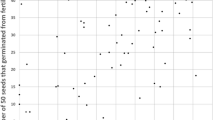Summary
-
1.
The treatment of spring-grown Irish Cobbler, Katahdin, Chippewa and Warba potato tubers with sodium thiocyanate solution will shorten the rest period sufficiently so that a marketable crop of potatoes may be obtained on the Eastern Shore of Maryland.
-
2.
The treated spring-grown seed of the Irish Cobbler will come up approximately two weeks later than seed from the previous year kept in cold storage; whereas the treated seed of the Katahdin and Chippewa varieties will come up approximately one week later. With the Warba variety in a one-year test, results seem to indicate that treated seed and stored seed will emerge at approximately the same time.
-
3.
The plants from the treated seed of the Irish Cobbler, Katahdin and Chippewa varieties will come up over a period of one or two weeks and a reduction in stand may be expected. In a one year test with the Warba variety all the plants germinated at the same time and the stand from treated and stored seed was almost the same.
-
4.
There seem to be good commercial possibilities with the Warba variety in the production of a late potato crop in Maryland from spring-grown seed by soaking the cut tubers for one hour in a solution of sodium thiocyanate (one pound to twelve gallons of water) immediately before planting.
Similar content being viewed by others
Literature Cited
Appleman, C. O. 1914. Biochemical and physiological study of the rest period in the tubers of Solanum tuberosum. Md. Agr. Exp. Station Bull. 183:181–226.
Denny, F. E. 1926. Hastening the sprouting of dormant potato tubers. Amer. Jour, of Bot. 13:118–125.
Loomis, W. E. 1927. Temperature and other factors affecting the rest period of potato tubers. Plant Physiol. 2:287–302.
McCallum, W. B. 1909. Plant Physiology and Pathology. Ariz. Agr. Exp. Sta. Ann. Rept. 20:583–586.
Müller-Thurgau, H. 1882. Uber Zuckeranháüfung in pflanzentheilen in folge niederer temperatur. Landw. Jahrb. 11:751–828.
Rosa, J. T. 1924. Abbreviation of the dormant period in potato tubers. Amer. Soc. Hort. Sei. Proc. (1923) 20:180–187.
—. 1925. Report on potato dormancy abbreviation experiments. Potato Assoc. (1924) 11:48–52.
—. 1925. Shortening the rest period of potatoes with ethylene gas. Potato News Bull. 2:363–365.
Stuart, William and Milstead, E. H. 1934. Shortening the rest period of the potato. U. S. Dept. of Agr. Tech. Bull. 415:1–32.
Author information
Authors and Affiliations
Additional information
Specialist in Plant Pathology
Asst. Specialist in Plant Pathology
]Formerly Asst. Specialist in Plant Pathology
The writers wish to acknowledge their indebtedness to R. T. Grant, County Agent of Worcester County, Md., and to Willard T. Pilchard for assistance in conducting experiments reported in this paper
Rights and permissions
About this article
Cite this article
Jehle, R.A., Walker, E.A. & Heuberger, J.W. Preliminary report on the use of spring grown seed for planting the late potato crop on the eastern shore of maryland. American Potato Journal 14, 290–293 (1937). https://doi.org/10.1007/BF02874450
Issue Date:
DOI: https://doi.org/10.1007/BF02874450




